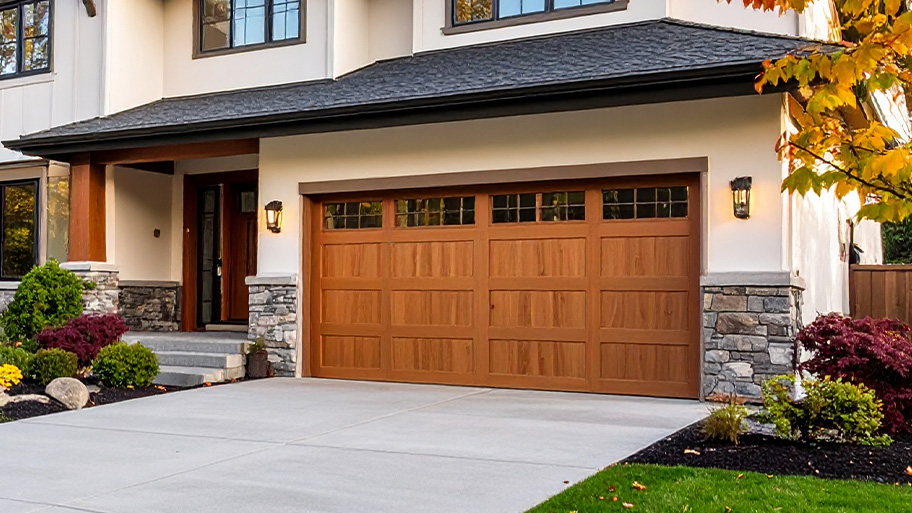
Replacing a garage door is necessary to add security and value to your home. Learn how each door type affects the total cost of this project in Denver, CO.
Here's how to frame a garage door


This project is costly to DIY, and making a mistake could immediately double the cost. Call a pro for a job done well the first time.
If there's a new garage door in your future, you have to tackle framing first. While learning how to frame a garage door isn't a Herculean task, it does require a nearly supernatural level of precision. One slight miscalculation will cause your rough opening to be the wrong size. Here's a guide to framing a garage door yourself.

You need to make sure that your rough opening is bigger than the garage door that's about to go in. Measuring the door's rough opening confirms that the distance between the floor and header is 1 1/2 inches longer than the door's height. We're also confirming that the header is 9 inches wider than the door. When measuring from left to right at the edges, the rough opening should be 3 inches longer than the door.
Using your tape measure, measure the distance from floor to ceiling. Trace the length of the lumber that will be used as a jamb. Next, cut out two pieces of lumber that will be used for something called a goal post that acts as the jamb that moves from floor to ceiling.
The head jamb, also known as the header frame, is a piece of wood that goes at the top of the door opening's frame. It should be installed before the side jambs because it provides a place for them to rest. The length of the head jamb is determined by measuring the width of the garage door's rough opening. A rough opening needs to be 9 inches longer than the garage door's width. First, cut your jamb to the right height. Next, fasten it to the header using framing nails.

Use framing nails to secure your goal post in place with the two pieces of the structure installed on the garage door's interior surface. Precision is important here because your goal post marks the spots where your garage door tracks will attach to the interior wall.
If you discover that your measurements were slightly off after installation, you can trim the edge to make sure everything fits perfectly.
When you position your side jambs in place, make sure that they touch the bottom of the head jamb. The side jams should be the same height as the garage door after you subtract 1/4 inch. The gap is necessary because you don't want to place your jambs directly against the floor.
Once the jambs are in place, secure them with nails. One pro tip is to install double-sided door jambs to provide holistic support for the frame.
Finally, cut a piece of lumber to cover the distance from the top of your header to the garage ceiling. Once perfectly centered, the piece placed above the header will be attached to the center bracket of the garage door's spring system.
As you’re working on this project, be aware of these common mistakes and avoid them so you frame your garage door correctly.
Incorrect measurements can result in a garage door frame that is too small or too large for the door, leading to problems with the door’s operation. Triple-check your measurements, and consider having a friend or family member check them as well for assurance.
If you don’t anchor the frame securely to the surrounding studs or don’t use enough hardware for the frame, it might not have enough support to operate correctly. Extra support should always be added in heavy-load areas.
When the frame isn’t plumb and level, the door could operate unevenly and stress the entire garage door system. Use a high-quality level and work slowly and carefully to align the frame precisely.
Garage door framing has specific measurement requirements that ensure the installation is done correctly. Keep these figures and details in mind when preparing for your garage door framing:
The rough opening of the garage door should be 3 inches wider than the door itself; if the door is 10 feet wide, the rough opening would be 10 feet, 3 inches
The rough opening height should be one-and-a-half inches taller than the door
The rough opening of the top jamb will need to be 1 ½-inches higher than the finished opening, so once the jamb is added, the opening will be brought down to the finished height
The head room—the area immediately above the door opening—usually requires 12 inches, if no garage door operator is being installed. If an opener motor will be installed, you will want at least 16-inches
For the back framing, you will likely need two 2x6s to the back of the frame from the floor to as high as the hardware will go; often, for standard hardware, this is 18 inches above the header
Lights, fans, and attic stairs must be located outside of the door’s movement area
If you are wiring the garage to include an opener motor, you should consider where you will place the electrical wirings and the wall button; otherwise, you could have wires running across your ceiling
While these are common requirements, your garage door might have different ones, depending on the manufacturer and size. It’s best to check with a local garage pro to confirm the requirements.
While framing a door's rough opening is something that a motivated person can learn, the truth is that learning how to frame a garage door isn't something most people can do overnight. The risk here is that framing a garage door incorrectly can lead to a poorly installed door that can result in hazards. The most common mistake people make when framing garage doors is creating an opening that's too wide for the doorway.
The good news is that your local garage door installers can take care of framing for you.
From average costs to expert advice, get all the answers you need to get your job done.

Replacing a garage door is necessary to add security and value to your home. Learn how each door type affects the total cost of this project in Denver, CO.

Our guide breaks down pricing factors, spring types, and why professionals help ensure safety and longevity. Learn what to expect and budget for your repair.

Garage door tune-ups aren’t too expensive, and most of the fixes are simple. That being said, simple doesn’t always mean safe, so it’s best to hire a pro for this project.

Learn how to open your garage door manually during an outage safely without damaging the garage door. Never get stuck again.

Winterizing your garage door can help you throughout the year, not only in the winter. Using this guide, you’ll learn how adding items such as insulation and even table salt can help prevent your garage door from freezing.

A broken garage door needs to be fixed by a pro. Here are the top questions you should ask about garage door repair when hiring a contractor.